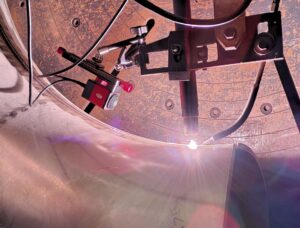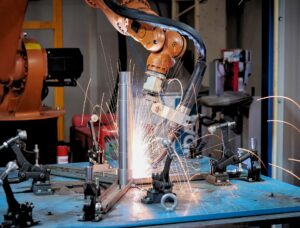In this blog, we’ll explore how welding cameras are used in difficult environments and how rugged design and advanced optics enable quality monitoring in the most challenging welding conditions. Welding rarely happens in ideal conditions. In the real world, welds are made inside tight pipe joints, on offshore rigs, deep in ship hulls, or within the containment zones of power plants. These environments are not only hazardous to workers—they’re also brutal on equipment. That’s where the weld monitoring system proves its worth. From extreme heat to heavy vibration and smoke-filled air, these cameras are built to endure what traditional tools can’t. In this article, we’ll explore how welding cameras perform in difficult environments, and why their rugged design and advanced optics make them indispensable for high-stakes welding applications.
1. Withstanding Extreme Heat
Welding arcs generate temperatures over 6,000°C (10,800°F), not to mention ambient heat from the metal, workpiece, and environment. Most electronic devices fail under such conditions—but welding cameras is specifically engineered for thermal resilience.
How they handle it:
- Heat-resistant housings made from stainless steel or ceramic composites
- Active or passive cooling systems (air or water-cooled enclosures)
- Heat shielding and thermal insulation to protect internal components
- Remote placement with fiber optic or relay lenses to distance the core system from the arc
These features allow cameras to operate continuously during welding, even in preheat-intensive processes like submerged arc welding (SAW) or cladding in heavy fabrication.
2. Surviving Constant Vibration and Impact
Industrial welding—especially on ships, pipelines, or structural steel—often involves platforms that vibrate from machinery, cranes, or worksite activity. Over time, this vibration can destroy conventional camera setups.
How welding cameras manage:
- Ruggedized camera mounts and dampeners to absorb shock
- Vibration-tested designs for automotive and aerospace compliance
- Compact, low-profile form factors to reduce mechanical stress
- Reinforced cable connections and sealed enclosures
This resilience makes them ideal for robotic welding arms, shipyard gantries, and automated production lines, where constant motion is the norm.
3. Seeing Through Smoke, Fumes, and Spatter
Arc welding processes naturally produce intense smoke, UV light, fumes, and molten metal spatter—all of which obscure visibility and threaten camera optics.
Here’s how advanced welding cameras overcome these obstacles:
- Specialized filters (e.g., optical bandpass, UV/IR filters) reduce glare and arc brightness
- High dynamic range (HDR) sensors adapt to contrast between the arc and the workpiece
- Auto-exposure and arc suppression algorithms enhance clarity in dynamic scenes
- Self-cleaning lenses or air-knife systems keep optics clear of debris
- Real-time image enhancement software helps operators interpret the footage
These features make it possible to see the weld pool clearly, even in low-visibility conditions—helping detect misalignment, porosity, or poor fusion before it becomes a weld defect.
4. Operating in Confined or Hazardous Spaces
Whether it’s a nuclear facility, a pressure vessel, or the interior of a pipeline, some welds can’t be accessed without putting humans at risk.
welding cameras allow remote inspection and monitoring, removing the need for in-person supervision in hazardous zones.
Typical solutions include:
- Compact, flexible camera heads mounted on borescopes or robotic arms
- Wireless or networked camera feeds with live-streaming capabilities
- Explosion-proof housings for flammable or chemical-prone areas
- Real-time overlays with thermal imaging or weld analytics
This is especially critical for industries like oil & gas, offshore energy, and defense, where safety regulations prohibit direct human exposure.
Final Thoughts
Welding cameras are more than just recording tools—they’re mission-critical systems designed to function where others fail. With advanced optics, hardened designs, and real-time processing, they allow operators and engineers to monitor welding processes in the harshest environments on earth.
Whether you’re welding inside a power plant, on the deck of a ship, or deep in a structural beam, these cameras give you the eyes you need—when you need them most.
Explore Rugged Camera Solutions Built for Your Application
At Mecaweld, we help industries deploy welding camera systems that survive heat, vibration, fumes, and more. Get in touch to learn how our welding cameras can support your operations, no matter the environment.



